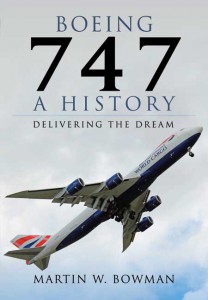A book about one type of airplane? At first I was afraid for an endless list of facts. But the development and course of life of this iconic plane however read like a novel: red ears from time to time, a lot of astonishment and sometimes straight emotion!
After the Boeing 707 and dreaming about a supersonic next step (in Europe concretised, but financial a black hole), Boeing came in 1965 with the Jumbo Jet. When in a picture you see the 707 and 747 from the side, standing next to each other, the name ‘Jumbo’ is obviously well chosen. For more than 20 years Boeing had no competition! The development, the taking in use of (200 planes sold from the drawing table!) and the ups and downs of the Boeing 747 till 2014 updated, are set out.
Once I was chef Aviation at Fokker during the prototype building of the Fokker 50 and 100 and did I sign for air credibility for the first flight of both types. From that perspective I have mostly read the part about the development of this plane letter by letter. The scars on my soul, inflicted by Fokker, came upon me loud and clear again! One of the humoristic details is that the test pilot was so famous for the great height of his ‘office’ that he ordered to build a life-seize mock-up, with which he was driven around the airport behind a truck!
During the development as well as during the operational use there were climaxes and down falls. First the engines gave a lot of reason for worry; during the use by airlines and maintenance around the whole world some things have gone horribly wrong. The detailed description of the accidents as a sober fact list and without any blown up drama, I find of a high standard. The largest disaster ever (Tenerife) is for example set out in a way that there is no focus on the quilt question, but a detailed description of what has happened in both involved 747’s. A ‘climax’ in the describing of incidents forms the experience of ‘lost all four engines’ from BA captain Eric Moody and his crew by the passing through of the ash cloud of the volcano Galunggung (Java). Not a year later a KLM Boeing 747 encountered the same problem by Anchorage (Alaska). Bizarre detail is that in both cases they first thought it was a control fault..
The user results of the different types of the plane and the way in which continuously response was given to the market developments fill a huge and interesting part of this book. In the end ‘the competition’ did came with more and more effective answers to the Boeing 747. The Airbus with her A380 forms the conclusion in it: finally an airplane that is bigger and also has a large growing capacity.
I find this book about the course of life of the Boeing 747 an achievement; surely also for the flight technical information. A particular book for the interested reader!












Leave a Reply